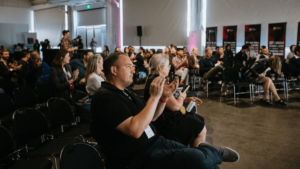This is a guest post from James Nicoll, Content Specialist at The Events Structure. You can connect with him on Twitter @eventsstructure.
You’ll have heard the saying ‘failing to prepare is preparing to fail’ – and when it comes to organising your marketing event, that old adage rings truer than ever.
But it’s the lack of preparation for what comes next – after the event – that seems to be one of the most common errors.
We’ve gathered together some top tips to help you guarantee the best possible return on your investment. Use them well, and you can be sure your follow-up is as successful as the event itself.
1. Make your move sooner rather than later
When the banner stands come down and the business cards are tucked away, the connections you worked to win can easily be forgotten if you don’t act fast.
Your competitors will be quick off the mark when it comes to follow-ups – and if you don’t want them to poach your most desirable prospects, the key is to make contact as soon as possible.
However you’re planning on reaching out to your potential clients, it’s good practice to have a follow-up plan in place before your event – even if it’s just a breakdown of things they should know about your business.
It’s also crucial to keep in mind that attendees will likely have made a number of new contacts and signed up to many mailing lists beyond your own – so remind them of who you are at the earliest available opportunity.
On top of ensuring you’re on their radar, a fast follow-up means you’re also likely to impress them with your efficient, proactive approach. This guarantees a strong professional relationship from the outset and gives you the chance to positively influence your working reputation.
In the digital age, social media has become a staple of 21st century living – and according to NewsCred, 87% of B2B marketers are using it when it comes to professional communications. Leading networks are playing an increasingly prominent role in the way businesses communicate – so why not utilise this fruitful, free resource when it comes to turning prospects into clients?
Whether it’s Twitter, Facebook or LinkedIn, you don’t necessarily have to contact your prospects via their accounts to gather useful information. Social media accounts offer a wealth of valuable insight into the way your potential new client runs their business and could help you gain a deeper understanding of their company before you reach out to them. Although you want to contact your interested prospect as soon as possible, investing a small amount of time in checking out their business’s social media accounts could be beneficial to your future relationship with them.
Once you do make these social connections, you’re not only successfully following-up on one lead from your event but, via communicating with them, offering your own brand the reach to all their followers too.
2. Tailor your approach
While Gartner Research predicts that, by 2020, 85% of B2C relationships will take place without any human interaction, not everyone in the marketing world agrees.
One of the greatest benefits of a marketing event is the chance to engage in some good old-fashioned one-on-one communication.
As well as discussing things you might overlook when writing an email, exhibiting at an event gives you the opportunity to get to know the client on a more personal level – for example, you can get a feel for why they’re at the event, which companies they’re looking to connect with and their aspirations for taking their brand forward.
This information will all be hugely beneficial when you’re starting to think about what your brand can bring to their business – and particularly how doing business with you will help them to achieve their professional goals. However, without an effective follow-up strategy, the time you’ve sunk into getting to know your audience has ultimately been wasted – and this is where a bespoke approach is essential.
When you commence the actual outreach, keep in mind that there’s no ‘one size fits all’ when it comes to effective contact. While a blanket email will undoubtedly save you time, no two companies are the same and sending them what’s little better than an automated spam email is likely to have a detrimental effect.
There are a range of ways to communicate with clients following an event, whether you opt for a phone call, an email or a friendly tweet, but one method of contact will not be appropriate for every business.
If the connection you’re contacting operates 90% of their business through social media, an informal tweet might be a more effective way of getting in touch with them – as opposed to sending a lengthy email.
Alternatively, if you’re contacting the CEO of a particularly reputable company, a friend request on Facebook is unlikely to give them the right impression of your understanding of their business and what you can offer them.
3. Make sure what you’re offering is valuable
As well as the way in which you approach a prospective client, the information you’re offering them in your follow-up is also a major factor in the chances of its success.
If they had queries at your marketing event about a particular area of your business and you fail to address them during your initial contact, this gives an immediate impression that their needs aren’t one of your primary concerns and you’ve forgotten the content of the original conversation.
One way to avoid this professional faux pas is by making a quick note about each person you meet and any specific queries they have. By recording any particular issues raised, questions asked or noteworthy specifics, you’re more likely to have a basis for something to discuss with them when it comes to approaching them at a later date. Jot these snippets down next to their contact details to ensure you don’t lose them or confuse their business details with someone else’s.
Summary
These 3 fundamental tips are tied together by one key theme: knowing your audience. Without applying appropriate customer relationship management (CRM) techniques, both during and after your event, your long-term goals will never come to fruition.
Implementing CRM best practices during your marketing event is the key to converting your face-to-face audience engagement into a bountiful customer relationship in the long run.
The Events Structure provides state-of-the-art exhibition trailers to business owners looking to maximise brand engagement, including bespoke exhibition trailers, promotional vehicles and inflatable event structures.
Why not share your key tips for effective event marketing follow-up below!





